Themed collection 2019 Catalysis Science & Technology HOT Articles

Design and engineering of whole-cell biocatalytic cascades for the valorization of fatty acids
This review presents the key factors to construct a productive whole-cell biocatalytic cascade exemplified for the biotransformation of renewable fatty acids.
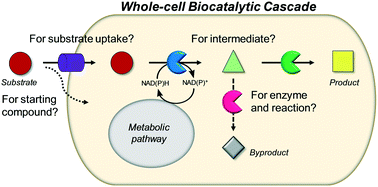
Catal. Sci. Technol., 2020,10, 46-64
https://doi.org/10.1039/C9CY01802F
Coordination chemistry and catalysis with secondary phosphine oxides
Review on synthesis, coordination chemistry and catalysis with secondary phosphine oxides.
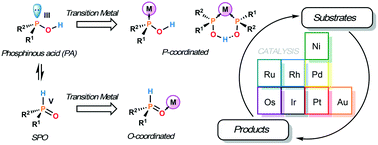
Catal. Sci. Technol., 2019,9, 5504-5561
https://doi.org/10.1039/C9CY01501A
Synthesis of enantiomerically pure alcohols and amines via biocatalytic deracemisation methods
Deracemisation via chemo-enzymatic or multi-enzymatic approaches is the optimum substitute for kinetic resolution, which suffers from the limitation of a theoretical maximum 50% yield albeit high enantiomeric excess is attainable.
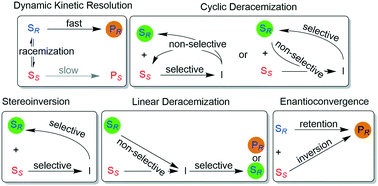
Catal. Sci. Technol., 2019,9, 5487-5503
https://doi.org/10.1039/C9CY01539F
PLP-dependent enzymes as important biocatalysts for the pharmaceutical, chemical and food industries: a structural and mechanistic perspective
PLP-dependent enzymes described on this review are attractive targets for enzyme engineering towards their application in an industrial biotechnology framework.

Catal. Sci. Technol., 2019,9, 4864-4876
https://doi.org/10.1039/C9CY01210A
Transition metal silicides: fundamentals, preparation and catalytic applications
Transition metal silicides as low-cost and earth-abundant inorganic materials are becoming indispensable constituents in catalytic systems for a variety of applications and exhibit excellent properties for sustainable industrial process.
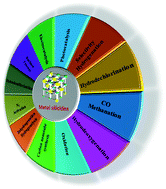
Catal. Sci. Technol., 2019,9, 4785-4820
https://doi.org/10.1039/C9CY00533A
Recent advances in Fe-catalyzed C–H aminations using azides as nitrene precursors
The intramolecular Fe-catalyzed amination of C–H bonds using azides as nitrene precursors represents an elegant approach toward N-heterocycles. This review summarizes the most recent achievements while focussing on fundamental mechanistic aspects.
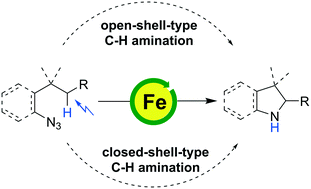
Catal. Sci. Technol., 2019,9, 4188-4197
https://doi.org/10.1039/C9CY00675C
Bifunctional catalysts for the hydroisomerization of n-alkanes: the effects of metal–acid balance and textural structure
The summary of recent advances reveals excellent potentials for the preparation of novel bifunctional catalysts with excellent catalytic performances for n-alkane hydroisomerization.
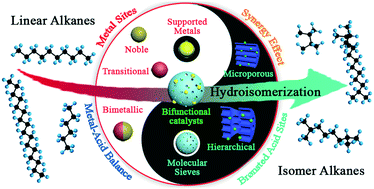
Catal. Sci. Technol., 2019,9, 4162-4187
https://doi.org/10.1039/C9CY00499H
Recent advances in the catalytic hydroboration of carbonyl compounds
The latest development in the catalytic hydroboration of C![[double bond, length as m-dash]](https://www.rsc.org/images/entities/char_e001.gif) O groups is summarized in this review. Access to borate ester intermediates provides a pathway to convert them into the corresponding valuable functionalized alcohols.
O groups is summarized in this review. Access to borate ester intermediates provides a pathway to convert them into the corresponding valuable functionalized alcohols.
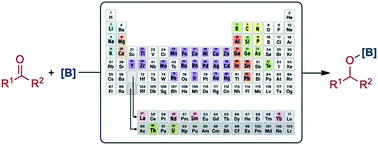
Catal. Sci. Technol., 2019,9, 3307-3336
https://doi.org/10.1039/C9CY00807A
Mini-review on an engineering approach towards the selection of transition metal complex-based catalysts for photocatalytic H2 production
Advances in transition-metal (Ru, Co, Cu, and Fe) complex-based catalysts since 2000 are briefly summarized in terms of catalyst selection and application for photocatalytic H2 evolution.
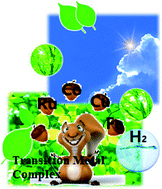
Catal. Sci. Technol., 2019,9, 2716-2727
https://doi.org/10.1039/C8CY02581A
Methane selective oxidation to methanol by metal-exchanged zeolites: a review of active sites and their reactivity
A review of the recent progress in revealing the structures, formation, and reactivity of the active sites in Fe-, Co-, Ni- and Cu-exchanged zeolites as well as outlooks on future research challenges and opportunities is presented.

Catal. Sci. Technol., 2019,9, 1744-1768
https://doi.org/10.1039/C8CY02414F
In situ UV-Raman spectroscopy of the coking-caused deactivation mechanism over an Mo/HMCM-22 catalyst in methane dehydroaromatization
Mo speciation and coking progress over the Mo/HMCM-22 catalysts were investigated via in situ UV-Raman spectroscopy in both MDA process and catalyst regeneration by O2.
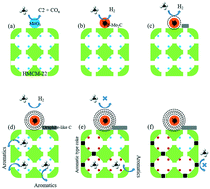
Catal. Sci. Technol., 2019,9, 6552-6555
https://doi.org/10.1039/C9CY01932D
Catalytic enhancement on Ti–Zr complex oxide particles for electrochemical hydrogenation of oxalic acid to produce an alcoholic compound by controlling electronic states and oxide structures
Ti0.9Zr0.1O2 complex oxide particles exhibit superior catalytic performances for the direct power storage into glycolic acid via electroreduction of oxalic acid due to favorable crystallinity.
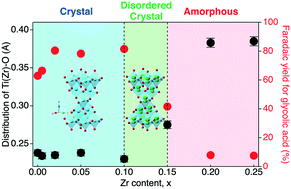
Catal. Sci. Technol., 2019,9, 6561-6565
https://doi.org/10.1039/C9CY01541H
Facile synthesis of impurity-free iron single atom catalysts for highly efficient oxygen reduction reaction and active-site identification
A precursor-dilution strategy is developed to prepare an impurity-free Fe single atom catalyst with superior oxygen reduction reaction catalytic performance.
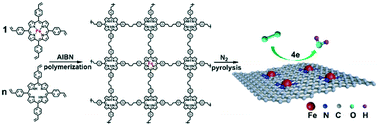
Catal. Sci. Technol., 2019,9, 6556-6560
https://doi.org/10.1039/C9CY01512D
Aryl C–H amination initiated by laccase-mediated oxidation of 4-phenylurazole
A mild amination of aryl C–H initiated by laccase-mediated oxidation of 4-phenylurazole is described.

Catal. Sci. Technol., 2019,9, 4216-4221
https://doi.org/10.1039/C9CY00968J
Constructing Sn(II)-doped SrNb2O6 for visible light response driven H2 and O2 evolution from water
A wide band-gap photocatalyst SrNb2O6 was adjusted to response to visible light in H2 and O2 evolution due to the new electron state in its band gap created by the Sn(II) dopant.

Catal. Sci. Technol., 2019,9, 3619-3622
https://doi.org/10.1039/C9CY01080G
Hybrid PDI/BiOCl heterojunction with enhanced interfacial charge transfer for a full-spectrum photocatalytic degradation of pollutants
The strong interaction between BiOCl and PDI preferentially formed. Owing to the strongly coupled heterojunction interface and conjugated structure of PDI, a rapid interfacial charge transfer was allowed from PDI to BiOCl across the interface.
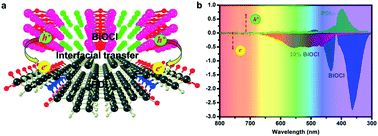
Catal. Sci. Technol., 2020,10, 372-381
https://doi.org/10.1039/C9CY01722D
Additively manufactured RANEY®-type copper catalyst for methanol synthesis
We describe a novel approach to prepare cellular methanol synthesis catalysts by combining additive manufacturing (AM) of a Cu–Al alloy followed by selective leaching of Al with aqueous NaOH solutions.
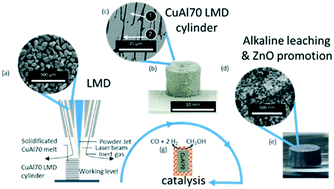
Catal. Sci. Technol., 2020,10, 164-168
https://doi.org/10.1039/C9CY01657K
Charge separation and molecule activation promoted by Pd/MIL-125-NH2 hybrid structures for selective oxidation reactions
The Pd/MIL-125-NH2 hybrid photocatalyst exhibits great advantages in charge separation and molecule activation, with sufficient generation of both superoxide radical and singlet oxygen toward selective oxidation of organic molecules.

Catal. Sci. Technol., 2020,10, 138-146
https://doi.org/10.1039/C9CY01690B
Photoelectrocatalytic oxidation of 3-pyridinemethanol to 3-pyridinemethanal and vitamin B3 by TiO2 nanotubes
In this paper, the first photoelectrocatalytic 3-pyridinemethanol oxidation to 3-pyridinemethanal and vitamin B3 was investigated.
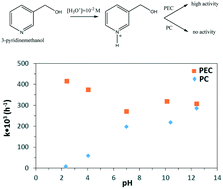
Catal. Sci. Technol., 2020,10, 124-137
https://doi.org/10.1039/C9CY01583C
Efficient asymmetric synthesis of chiral alcohols using high 2-propanol tolerance alcohol dehydrogenase SmADH2 via an environmentally friendly TBCR system
Based on substrate-coupled cofactor regeneration system, a high 2-propanol tolerance SmADH2 together with TBCR system can synthesise structurally diverse chiral alcohols at a high substrate loading with only 1.25 equivalents of 2-propanol.
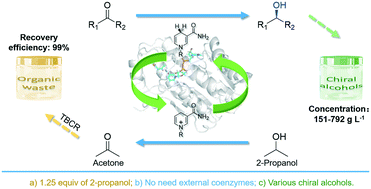
Catal. Sci. Technol., 2020,10, 70-78
https://doi.org/10.1039/C9CY01794A
Spatially separated cocatalysts for efficient charge separation: a hollow Pt/CdS/N–ZnO/CoOx graphene microtubule with high stability for photocatalytic reactions and sustainable recycling
The spatially separated Pt/CdS/N–ZnO/CoOx graphene microtubule (PCNZCo-GM) with double cocatalysts is prepared by a capillary action assisted hydrothermal method for enhancing charge separation efficiency and photocatalytic oxidation ability.
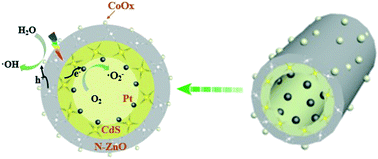
Catal. Sci. Technol., 2019,9, 6899-6908
https://doi.org/10.1039/C9CY01776C
Chemoselective reduction of quinoline over Rh–C60 nanocatalysts
Highly selective hydrogenation of quinoline by electron-deficient Rh species containing fullerene.
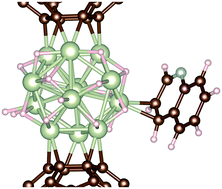
Catal. Sci. Technol., 2019,9, 6884-6898
https://doi.org/10.1039/C9CY02025J
Confinement of Pt nanoparticles in cage-type mesoporous silica SBA-16 as efficient catalysts for toluene oxidation: the effect of carboxylic groups on the mesopore surface
In this work, 3D cage-type mesoporous SBA-16 materials functionalized with –COOH groups are used to support Pt metals and provide high catalytic activity for toluene oxidation.
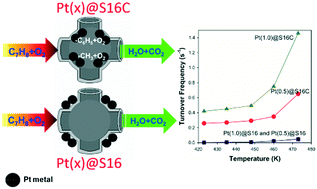
Catal. Sci. Technol., 2019,9, 6852-6862
https://doi.org/10.1039/C9CY01787A
The fabrication of Au/Pd plasmonic alloys on UiO-66-NH2: an efficient visible light-induced photocatalyst towards the Suzuki Miyaura coupling reaction under ambient conditions
The current study on Au/Pd@UiO-66-NH2 explores a novel approach towards photocatalytic SMC coupling reaction. This investigation highlights a well studied mechanistic pathway towards the formation of biphenyl as the target product.
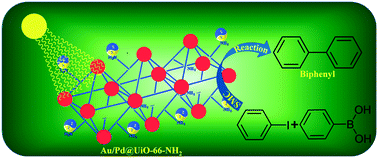
Catal. Sci. Technol., 2019,9, 6585-6597
https://doi.org/10.1039/C9CY01431D
Structure and surface characteristics of Fe-promoted Ni/Al2O3 catalysts for hydrogenation of 1,4-butynediol to 1,4-butenediol in a slurry-bed reactor
Nanostructured Ni–xFe/Al2O3 catalysts prepared by sol–gel combustion synthesis (SGC) display superior activity in hydrogenation of 1,4-butynediol to 1,4-butenediol. The Fe addition promoted the Ni reducibility and stabilized the Al2O3 structure.
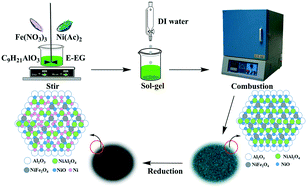
Catal. Sci. Technol., 2019,9, 6598-6605
https://doi.org/10.1039/C9CY01195A
Catalytic activation of ethylene C–H bonds on uniform d8 Ir(I) and Ni(II) cations in zeolites: toward molecular level understanding of ethylene polymerization on heterogeneous catalysts
The long-debated intermediates of ethylene polymerization are revealed using uniform d8 metal ions in zeolites.
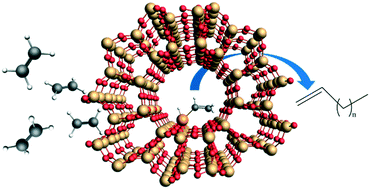
Catal. Sci. Technol., 2019,9, 6570-6576
https://doi.org/10.1039/C9CY01442J
Electrocatalytic conversion of carbon dioxide to formic acid over nanosized Cu6Sn5 intermetallic compounds with a SnO2 shell layer
FE towards formation of formic acid over Cu6Sn5 core–Sn oxide shell structure was higher than that of Sn plate and Sn NP/CB. We believe that the key factor affecting the high selectivity is a compressive strain of surface.
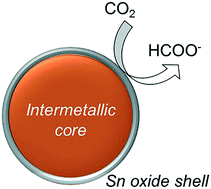
Catal. Sci. Technol., 2019,9, 6577-6584
https://doi.org/10.1039/C9CY01540J
N-doped hierarchical porous metal-free catalysts derived from covalent triazine frameworks for the efficient oxygen reduction reaction
The hierarchical structure enhances oxygen diffusion, improves electron transfer, and exposes more catalytic active sites for the ORR.
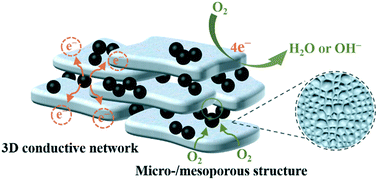
Catal. Sci. Technol., 2019,9, 6606-6612
https://doi.org/10.1039/C9CY01597C
Direct synthesis of acetic acid from carbon dioxide and methane over Cu-modulated BEA, MFI, MOR and TON zeolites: a density functional theory study
Cu-Modulated zeolites can be promising candidate catalysts in the direct conversion of carbon dioxide and methane to acetic acid.
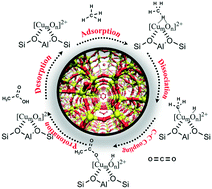
Catal. Sci. Technol., 2019,9, 6613-6626
https://doi.org/10.1039/C9CY01803D
Hydrosilylation of carbonyl and carboxyl groups catalysed by Mn(I) complexes bearing triazole ligands
Manganese(I) complexes bearing readily accessible triazole ligands are effective catalysts for the hydrosilylation of carbonyl and carboxyl compounds.
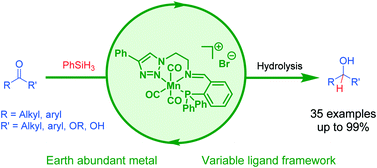
Catal. Sci. Technol., 2019,9, 6370-6378
https://doi.org/10.1039/C9CY01738K
Copper on the inner surface of mesoporous TiO2 hollow spheres: a highly selective photocatalyst for partial oxidation of methanol to methyl formate
To raise the methyl formate (MF) selectivity at high methanol conversion is one of the most challenging topics for photocatalytic partial oxidation of methanol to MF.

Catal. Sci. Technol., 2019,9, 6240-6252
https://doi.org/10.1039/C9CY01595G
Catalytic and biophysical investigation of rhodium hydroformylase
Rh-Containing artificial metalloenzymes based on two mutants of sterol carrier protein_2L (SCP_2L) have been shown to act as hydroformylases, exhibiting significant activity and unexpectedly high selectivity in the hydroformylation of alkenes.
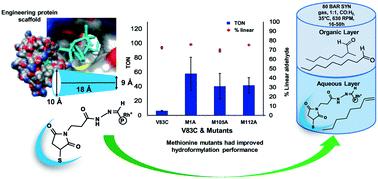
Catal. Sci. Technol., 2019,9, 6428-6437
https://doi.org/10.1039/C9CY01679A
The control effects of different scaffolds in chiral phosphoric acids: a case study of enantioselective asymmetric arylation
DFT calculations disclosed that the sign of enantioselectivity in chiral-phosphoric-acid catalyzed reactions can be tuned by BINOL- or SPINOL-derived backbones.
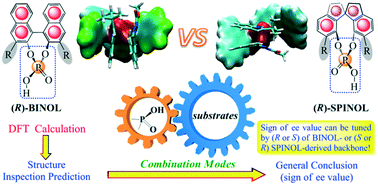
Catal. Sci. Technol., 2019,9, 6482-6491
https://doi.org/10.1039/C9CY01420A
The consequences of surface heterogeneity of cobalt nanoparticles on the kinetics of CO methanation
The CO hydrogenation reaction was studied under methanation conditions (H2/CO >3, 250–300 °C) on Co/SiO2 catalysts with different mean Co nanoparticle size (dp = 4 nm, 13 nm and 33 nm).
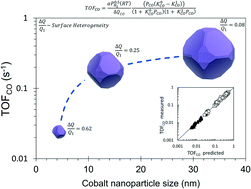
Catal. Sci. Technol., 2019,9, 6415-6427
https://doi.org/10.1039/C9CY01753D
Ir nanoparticles with ultrahigh dispersion as oxygen evolution reaction (OER) catalysts: synthesis and activity benchmarking
In this work, we present a facile and straightforward approach to synthesize, activate and benchmark small, i.e. 1.6 nm in diameter, Ir nanoparticles (NP) as oxygen evolution reaction (OER) catalysts.
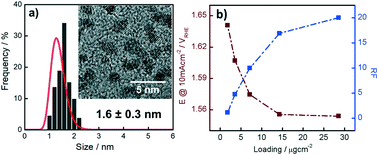
Catal. Sci. Technol., 2019,9, 6345-6356
https://doi.org/10.1039/C9CY01728C
Effect of the Si/Al ratio in Ga/mesoporous HZSM-5 on the production of benzene, toluene, and xylene via coaromatization of methane and propane
In this work, a series of GaOy supported on mesoporous HZSM-5 (GaOy/meso-XHZSM-5; Si/Al (X), X = 10, 20, 30, and 40) catalysts with different Si/Al molar ratios were prepared for use in the coaromatization of methane and propane.
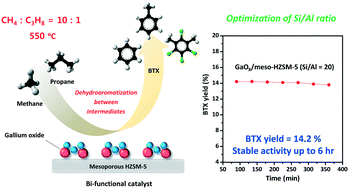
Catal. Sci. Technol., 2019,9, 6285-6296
https://doi.org/10.1039/C9CY01619H
Investigation of solvent effects on the hydrodeoxygenation of guaiacol over Ru catalysts
The effects of a liquid phase environment on the hydrodeoxygenation of guaiacol, a prototypical lignin derived compound, have been investigated over a Ru catalyst from first principles.
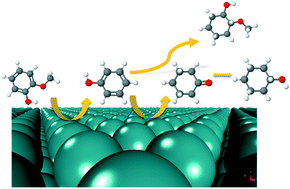
Catal. Sci. Technol., 2019,9, 6253-6273
https://doi.org/10.1039/C9CY01763A
Promoting surface oxygen vacancies on ceria via light pretreatment to enhance catalytic ozonation
Oxygen vacancies catalyzed ozone into hydroxyl radicals which accelerated organic mineralization. Light pre-treatment of ceria intensifies its oxygen vacancy defect levels which are central to its performance in catalytic ozonation.
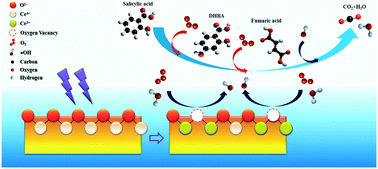
Catal. Sci. Technol., 2019,9, 5979-5990
https://doi.org/10.1039/C9CY01450K
A green-by-design bioprocess for L-carnosine production integrating enzymatic synthesis with membrane separation
This simple and clean bioprocess enables the economically attractive and environmentally benign production of the bioactive dipeptide L-Car.

Catal. Sci. Technol., 2019,9, 5971-5978
https://doi.org/10.1039/C9CY01622H
One step phenol synthesis from benzene catalysed by nickel(II) complexes
Nickel(II)complexes of N4-ligands are reported as efficient catalysts for direct benzene hydroxylation via bis(μ-oxo)dinickel(III) intermediate species. The exclusive phenol formation is achieved with a yield of 41%.
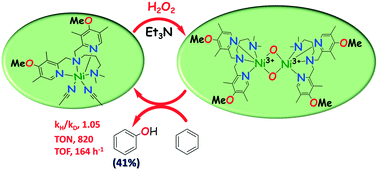
Catal. Sci. Technol., 2019,9, 5991-6001
https://doi.org/10.1039/C9CY01471C
Theoretical insight into the origin of the electrochemical promotion of ethylene oxidation on ruthenium oxide
In EPOC the adsorption energies of the reactants and products are modified by applying an electrochemical potential to the catalyst. DFT computations unveil that the C–C and O–O bond dissociation are accelerated under positive and negative potential, respectively.
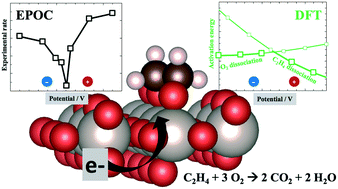
Catal. Sci. Technol., 2019,9, 5915-5926
https://doi.org/10.1039/C9CY01421G
Nickel-catalyzed aryl trifluoromethyl sulfide synthesis: a DFT study
A Ni(I)/Ni(III) catalytic cycle allows aryl trifluoromethyl sulfides to be obtained at room temperature from [NMe4][SCF3] and aryl halides.
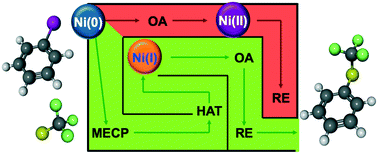
Catal. Sci. Technol., 2019,9, 5962-5970
https://doi.org/10.1039/C9CY01365B
Characteristics of L-threonine transaldolase for asymmetric synthesis of β-hydroxy-α-amino acids
Characteristic a L-threonine transaldolase (LTTA) and reaction conditions optimization for asymmetric synthesis of L-threo-β-hydroxy-α-amino acids.
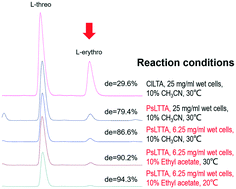
Catal. Sci. Technol., 2019,9, 5943-5952
https://doi.org/10.1039/C9CY01608B
Efficient photocatalytic reactions of Cr(VI) reduction and ciprofloxacin and RhB oxidation with Sn(II)-doped BiOBr
Efficient photocatalytic reactions of Cr(VI) reduction, ciprofloxacin and RhB oxidation with Sn(II) doped BiOBr.
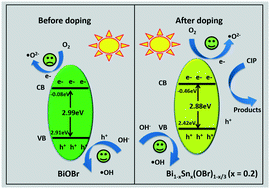
Catal. Sci. Technol., 2019,9, 5953-5961
https://doi.org/10.1039/C9CY01405E
Enhancement mechanism of sulfur dopants on the catalytic activity of N and P co-doped three-dimensional hierarchically porous carbon as a metal-free oxygen reduction electrocatalyst
A sulfur, nitrogen and phosphorus ternary-doped cattle-bone-derived hierarchically porous carbon metal-free electrocatalyst was synthesized, exhibiting superior oxygen reduction performance compared to Pt/C.
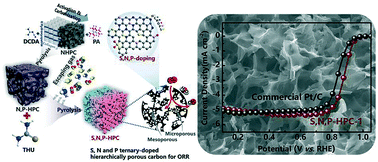
Catal. Sci. Technol., 2019,9, 5906-5914
https://doi.org/10.1039/C9CY01387C
A chemical titration method for quantification of carbenes in Mo- or W-containing catalysts for metathesis of ethylene with 2-butenes: verification and application potential
We introduce and experimentally validate a simple titration method for quantifying the number of carbenes acting as active sites in the metathesis of ethylene with 2-butenes over Mo- or W-containing catalysts.
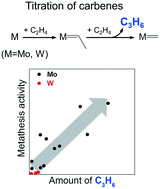
Catal. Sci. Technol., 2019,9, 5660-5667
https://doi.org/10.1039/C9CY01697J
Homogenous electrochemical water oxidation by a nickel(II) complex based on a macrocyclic N-heterocyclic carbene/pyridine hybrid ligand
Electrochemical water oxidation catalyzed by a homogeneous Ni–NHC/pyridine complex demonstrated electrolyte-dependent catalytic performances. The catalyst displayed a stable catalytic current of oxygen evolution in long-term bulk electrolysis.
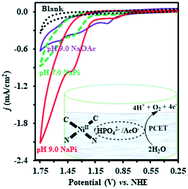
Catal. Sci. Technol., 2019,9, 5651-5659
https://doi.org/10.1039/C9CY01485C
Chiral salen Cr(III) complexes encapsulated in thermo-responsive polymer nanoreactors for asymmetric epoxidation of alkenes in water
Thermo-responsive polymer nanoreactors containing chiral salen Cr(III) complexes exhibited unprecedented efficiency and facile reusability in asymmetric epoxidation of unfunctionalized olefins in water.
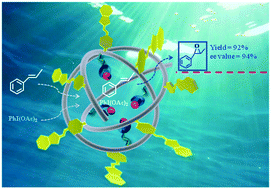
Catal. Sci. Technol., 2019,9, 5626-5635
https://doi.org/10.1039/C9CY01398A
Amorphous Fe2O3 for photocatalytic hydrogen evolution
Fe2O3has drawn significant attention in photocatalysis due to its natural abundance, thermodynamic stability, environmental compatibility, low toxicity and narrow bandgap.
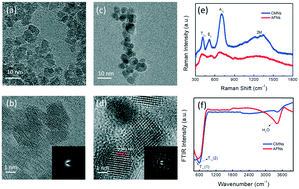
Catal. Sci. Technol., 2019,9, 5582-5592
https://doi.org/10.1039/C9CY01621J
Ceria imparts superior low temperature activity to nickel catalysts for CO2 methanation
Proposed reaction mechanism for CO2 methanation on NiAl-MO/CeO2-x catalysts.
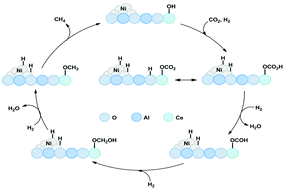
Catal. Sci. Technol., 2019,9, 5636-5650
https://doi.org/10.1039/C9CY01186B
Theoretical study of the ligand effect on NHC–cobalt-catalyzed hydrogenation of ketones
Theoretical study of ketone hydrogenation revealed that the catalyst regeneration step is more sensitive to the ligand effect.
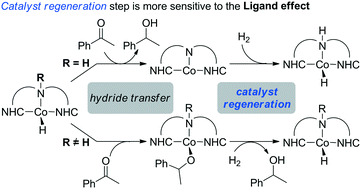
Catal. Sci. Technol., 2019,9, 5315-5321
https://doi.org/10.1039/C9CY01239G
Enhancing hydrogen evolution activity by doping and tuning the curvature of manganese-embedded carbon nanotubes
Doping heteroatoms (Mn and N) and tuning the curvature of carbon nanotubes could efficiently elevate the C p-band center, lower the absolute electrode potential, and thus enhance the HER performance.
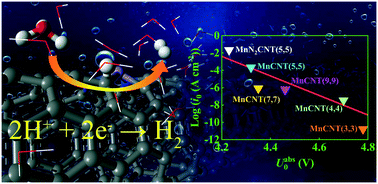
Catal. Sci. Technol., 2019,9, 5301-5314
https://doi.org/10.1039/C9CY01174A
Photocatalytic hydrogen energy evolution from antibiotic wastewater via metallic bi nanosphere doped g-C3N4: performances and mechanisms
In this work, bismuth nanosphere doped polymeric carbon nitride (Bi/g-C3N4) was applied for photocatalytically converting antibiotic wastewater into hydrogen energy.
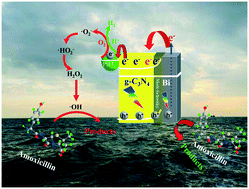
Catal. Sci. Technol., 2019,9, 5279-5291
https://doi.org/10.1039/C9CY01375J
Purposefully designing novel hydroxylated and carbonylated melamine towards the synthesis of targeted porous oxygen-doped g-C3N4 nanosheets for highly enhanced photocatalytic hydrogen production
A new hydroxylated and carbonylated melamine was purposefully designed and constructed for the synthesis of targeted porous O-doped g-C3N4 nanosheets.
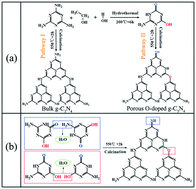
Catal. Sci. Technol., 2019,9, 5150-5159
https://doi.org/10.1039/C9CY01434A
Catalytic resonance theory: superVolcanoes, catalytic molecular pumps, and oscillatory steady state
Catalytic reactions on surfaces with forced oscillations in physical or electronic properties undergo controlled acceleration consistent with the selected parameters of frequency, amplitude, and external stimulus waveform.
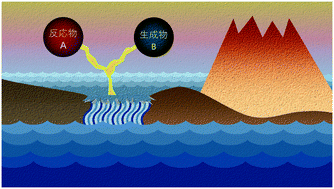
Catal. Sci. Technol., 2019,9, 5058-5076
https://doi.org/10.1039/C9CY01543D
Electricity-driven 7α-hydroxylation of a steroid catalyzed by a cytochrome P450 monooxygenase in engineered yeast
Schematic diagram of the cytochrome P450 monooxygenase-catalyzed BES.
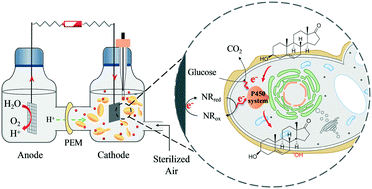
Catal. Sci. Technol., 2019,9, 4877-4887
https://doi.org/10.1039/C9CY01288E
Can Hammett indicators accurately measure the acidity of zeolite catalysts with confined space? Insights into the mechanism of coloration
The acidic properties of zeolite catalysts play a crucial role in governing catalytic performances, which makes the acidity characterization an important subject in the field of zeolite catalysis.
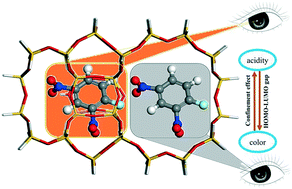
Catal. Sci. Technol., 2019,9, 5045-5057
https://doi.org/10.1039/C9CY01392J
Selective synthesis of 1,3-propanediol from glycidol over a carbon film encapsulated Co catalyst
A carbon film encapsulated Co NP catalyst (Co@NC) was highly active, selective and stable for the hydrogenation of glycidol to 1,3-PDO.
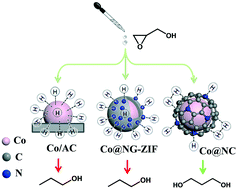
Catal. Sci. Technol., 2019,9, 5022-5030
https://doi.org/10.1039/C9CY01162E
Mono-substitution of symmetric diesters: selectivity of Mycobacterium smegmatis acyltransferase variants
Selective mono-substitution of symmetric diesters was demonstrated using an immobilized Mycobacterium smegmatis esterase/acyltransferase (MsAcT) variant.
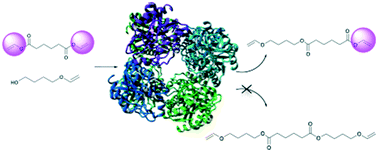
Catal. Sci. Technol., 2019,9, 4920-4927
https://doi.org/10.1039/C9CY01181A
Enhanced performance of bimetallic PtCo/MCM-41 catalysts for glycerol oxidation in base-free medium
Optimizing the electronic coupling in heterogeneous catalysts by tuning metal–metal interactions remains a significant challenge.
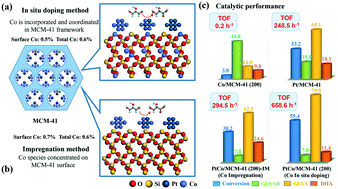
Catal. Sci. Technol., 2019,9, 4909-4919
https://doi.org/10.1039/C9CY01154D
Molecular-level understanding of reaction path optimization as a function of shape concerning the metal–support interaction effect of Co/CeO2 on water-gas shift catalysis
In this work, the active sites generated in hydrogen reduction and the reaction pathways for the water gas shift (WGS) reaction over Co/CeO2 catalysts were studied by in situ XAS and XPS coupled with DFT+U calculations.
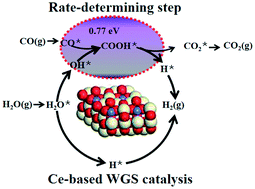
Catal. Sci. Technol., 2019,9, 4928-4937
https://doi.org/10.1039/C9CY01260E
Aldehydes rather than alcohols in oxygenated products from light-driven Fischer–Tropsch synthesis over Ru/SiC catalysts
The oxygenated products in light-driven Fischer–Tropsch synthesis over Ru/SiC catalysts are aldehydes rather than alcohols.
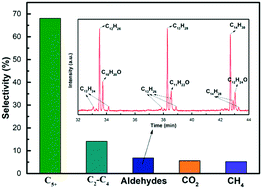
Catal. Sci. Technol., 2019,9, 4629-4632
https://doi.org/10.1039/C9CY00990F
Photocatalytic degradation of naproxen by a H2O2-modified titanate nanomaterial under visible light irradiation
A H2O2-modified titanate nanomaterial was synthesized to improve catalytic activity. The influencing factors, intermediate product transformation pathways and degradation mechanism of the photodegradation process of NPX by the HTNM were studied.
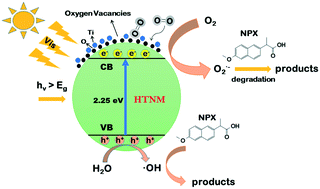
Catal. Sci. Technol., 2019,9, 4614-4628
https://doi.org/10.1039/C9CY00965E
Visible light-driven enhanced CO2 reduction by water over Cu modified S-doped g-C3N4
We synthesized Cu modified S-doped g-C3N4 thin sheets using calcination followed by a wet-impregnation method. The photocatalytic activity was studied for reduction of CO2 to CO and CH4 in the presence of water and a plausible mechanism is explained.
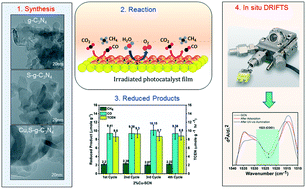
Catal. Sci. Technol., 2019,9, 4598-4613
https://doi.org/10.1039/C9CY01185D
Highly dispersed γ-Fe2O3 embedded in nitrogen doped carbon for the efficient oxygen reduction reaction
A sacrificial template strategy is developed to synthesize highly dispersed γ-Fe2O3 embedded in porous N-doped carbon. The as-synthesized catalyst exhibits high ORR performance and presents a power density of 112 mW cm−2 in zinc–air battery.

Catal. Sci. Technol., 2019,9, 4581-4587
https://doi.org/10.1039/C9CY01188A
Highly conformal deposition of ultrathin cobalt acetate on a bismuth vanadate nanostructure for solar water splitting
In this work, the effect of photochemically modifying nanoporous bismuth vanadate in Co2+ solution in acetate buffer (abbreviated as Co–Ac) on water oxidation was thoroughly studied.
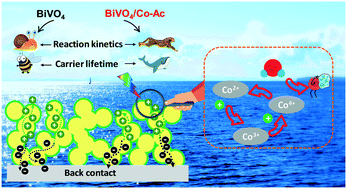
Catal. Sci. Technol., 2019,9, 4588-4597
https://doi.org/10.1039/C9CY00816K
Intermetallic species in the Negishi coupling and their involvement in inhibition pathways
The formation of M–Zn-intermetallic species (M = Ni, Pd) in the course of the Negishi reaction in THF solvent and their potential impact on in situ catalyst inhibition were investigated by DFT calculations carried out at two levels of theory.
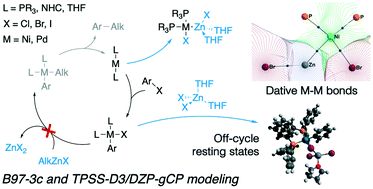
Catal. Sci. Technol., 2019,9, 4561-4572
https://doi.org/10.1039/C9CY00752K
First-principles microkinetic study of methane and hydrogen sulfide catalytic conversion to methanethiol/dimethyl sulfide on Mo6S8 clusters: activity/selectivity of different promoters
A large fraction of the global natural gas reserves is in the form of sour gas, i.e. contains hydrogen sulfide (H2S) and carbon dioxide (CO2), and needs to be sweetened before utilization.

Catal. Sci. Technol., 2019,9, 4573-4580
https://doi.org/10.1039/C9CY00375D
In situ DRIFT spectroscopy insights into the reaction mechanism of CO and toluene co-oxidation over Pt-based catalysts
The Pt–CeO2 catalyst with adsorption sites and oxygen-rich vacancies exhibited outstanding activity towards CO and toluene co-oxidation.
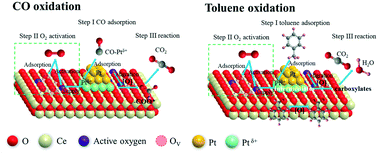
Catal. Sci. Technol., 2019,9, 4538-4551
https://doi.org/10.1039/C9CY00751B
Controlling the secondary pollutant on B-doped g-C3N4 during photocatalytic NO removal: a combined DRIFTS and DFT investigation
The mechanisms of enhanced photocatalysis efficiency and suppression of toxic intermediate production during photocatalytic NO oxidation on B-doped g-C3N4 were revealed.
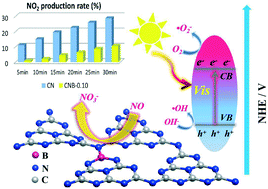
Catal. Sci. Technol., 2019,9, 4531-4537
https://doi.org/10.1039/C9CY01030K